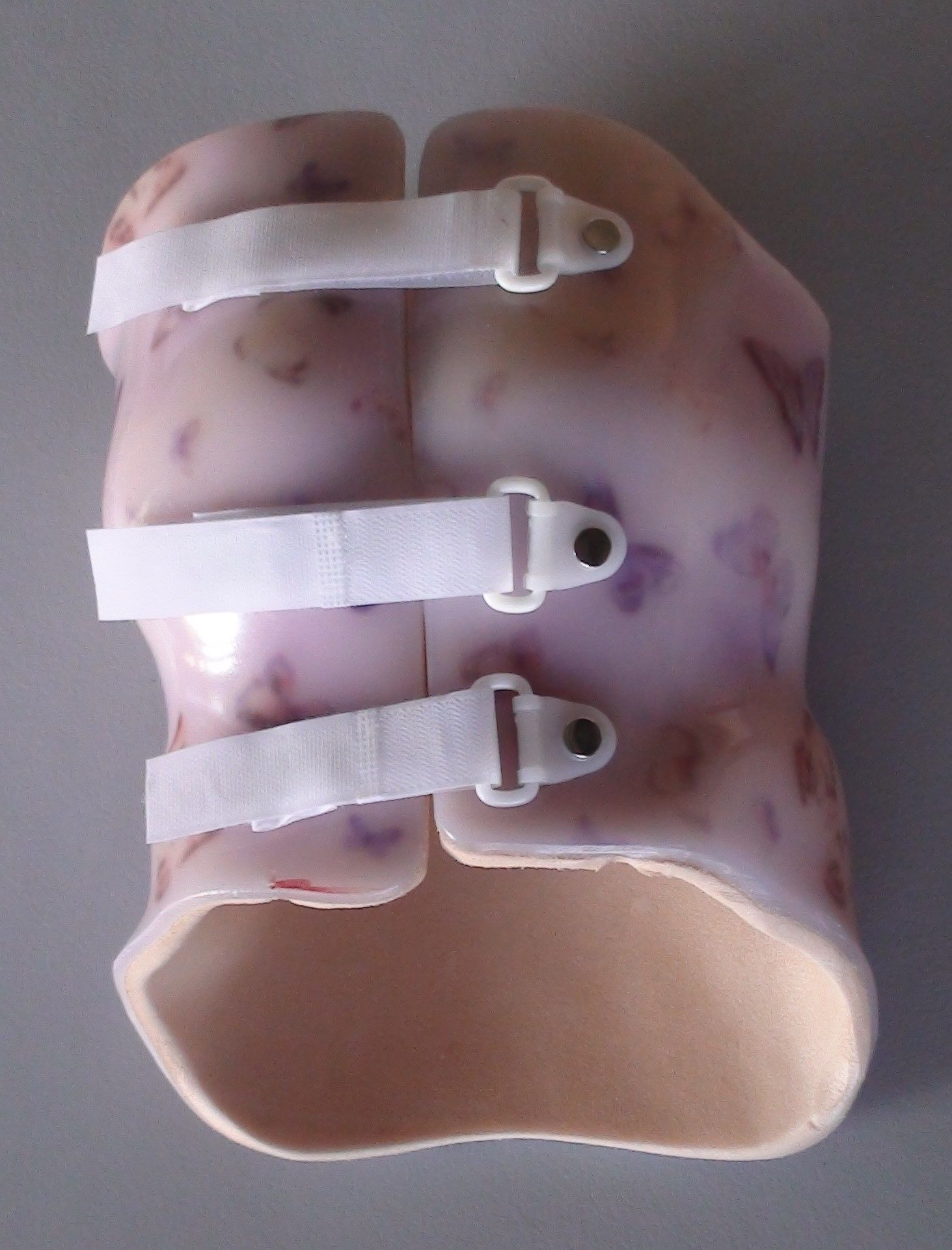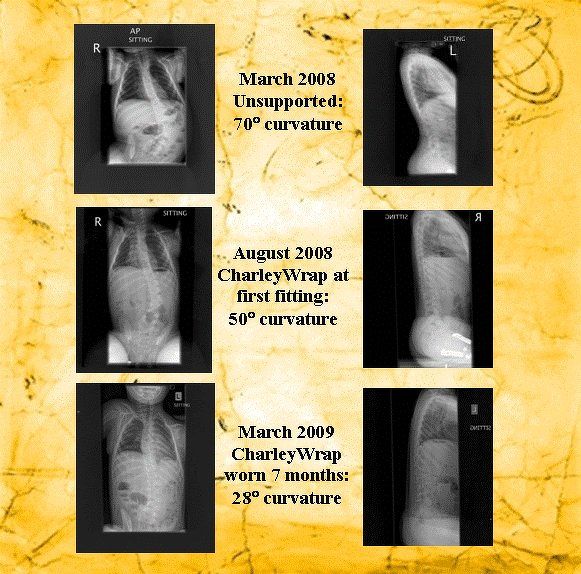The History of the CharleyWrap...
Our beautiful little girl, Charley, was born in September 2005. Due to birth asphyxia (lack of oxygen shortly after her birth), she suffered a massive brain injury which has left her with multiple disabilities, including severe cerebral palsy. She is blind, epileptic, and spastic tetraplegic (no purposeful movement of any limb, limited head control). Because of her low truncal strength, Charley was also difficult to physically position and handle. The cerebral palsy has caused Charley's spine to curve abnormally (scoliosis and lordosis). This happened very rapidly - going from virtually nothing to 70 degrees in just three months, shortly after her second birthday.
Our Treatment Options
To give an idea to those that don’t know about the degrees, the suggested treatment is as follows...
20-30 degrees, the patient’s spine is monitored closely for changes.
30-40 degrees, bracing is recommended.
40+ degrees, treatment is usually surgical, meaning that rods are
inserted either side of the spine permanently.
With regards to the surgical option, if the patient has not yet gone through puberty and their body is still growing (as Charley’s would have been for some years to come), multiple surgeries are needed (as often as twice a year) using what are termed Growth Rods - rods that are extended surgically as the child grows until puberty ends and the spine growth is complete. This was not an acceptable option for us, so we agreed to try bracing. Although some correction (straightening) is possible in some cases, no correction was anticipated. The main aim of the bracing was to stabilize it at 70 degrees, hoping that it wouldn’t worsen. The bracing systems we were offered are designed essentially as a stall tactic for the multiple surgeries. The hope is that if the child will tolerate it long enough to get through puberty, and therefore cessation of spinal growth, only one major surgery would be required, therefore avoiding as many surgeries as possible.

The beginning
A plaster cast was made of Charley’s torso, and eight weeks later she was fitted with her brace. The orthotic specialists made a big effort to make it pretty - hers was pink with butterflies. It was a fine piece of sculpturing, something that could easily have been an artwork. But when I looked at it I saw a medieval contraption, a torture chamber, a hard, heavy piece of body armor.
We researched the TLSO (thoraco lumbo-sacral-orthosis) bracing system offered and discovered that compliance of brace wearing was poor due to discomfort. We read personal stories from children across the world with scoliosis of differing severity and heard their overall dissatisfaction. For these and many other reasons, we rejected its use on our little girl.
Trial and Error
Charley would have needed to wear the brace 23 hours a day - she has not been in it for 23 minutes. We searched for current alternatives and found nothing appropriate existed. We asked the orthopaedic specialist for an opinion on a corset based idea. We were told that families had tried before and “failed, failed, failed”, and that “thirty years of medical research and development have proven that it MUST be a solid, rigid structure”. Going against medical advice, we decided to experiment ourselves. Knowing the braces were not an option for us, and being told that surgeries would become unavoidable, we felt we had nothing to lose. Our initial aim was to create a new way of supporting Charley’s positioning. We wanted something comfortable, discreet, simple to use, and with the ability to adjust to her changing body shape as we repositioned her throughout the day. Armed with background knowledge in structural engineering and a good dose of thought for our daughter’s support requirements, we developed the CharleyWrap - a boned “corset” of sorts. Every aspect of the design has been well thought out - from the choice of fabrics used, the multi-function fastening system, to the specific properties, ratio, and placement of the boning.

Success
From the first minute Charley wore our device, we saw an incredible difference to her truncal support. Her baby brother, Zak, was playing in the washing basket at the time. I got him to move to one end so that Charley could fit in too, and for the first time, I was able to support just her head, freeing up one hand to pass a toy between the two children - a small thing to most, but a truly magical moment for us! We knew then that we were really on to something.
Over time, we found that Charley appeared happier whilst wearing her new support, no doubt feeling more secure. It didn’t appear to be any worse than any other undergarment one might wear. It didn’t create pressure sores and didn’t restrict her breathing. We were able to realign her recently offset lateral supports in her wheelchair. Because the device wasn’t bulky, she remained able to utilise her high chair, standing frame and care seat without replacements being necessary. As she was able to comfortably wear it all day and all night, she no longer needed assistance with positioning aids in bed. Another advantage over other bracing devices was that, due to its discreet design, no-one could even tell she was wearing it.
We didn’t dare hope for the CharleyWrap to improve the spine. It was a great surprise to discover that it did! When first fitted, Charley’s scoliosis went from 70 degrees to 50 instantly. Three months later it went to 40 degrees. Three months after that it was at 28 - where it is still held today, 18 months down the track. As the paediatric orthopaedic surgeon at Starship hospital has said, “her sagittal alignment is now almost perfect”. (See “Results” for x-rays, and letter from Starship Hospital Spine Specialist, Dr Hamish Crawford).
A good analogy of our original idea is this: Think of a balloon. If you wrap a balloon with something that provides fairly even pressure, the air inside the balloon will want to go both up and down. That appears to be what is happening to Charley’s body - supported laterally, and elongating at the same time. We also believe that if you work on the bulk of the curve, the rest appears to follow.
The Future
It is early days for the CharleyWrap. Although we’ve had interest from some health providers, we have not yet done clinical trials or participated in any form of Research and Development - except our own, of course! We cannot say with any certainty what the CharleyWrap can do for your child. We can merely tell you what it has achieved for Charley, and offer it as a choice. We believe that it is a fabulous positioning tool, potentially a viable alternative to other bracing systems, and, for Charley and the other children currently using it, now there is hope of avoiding any future spinal surgeries - hope now exists where there was none before. We intend to keep using the CharleyWrap indefinitely.
